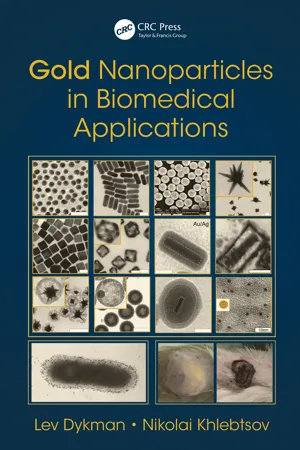
- 332 pages
- English
- ePUB (mobile friendly)
- Available on iOS & Android
Gold Nanoparticles in Biomedical Applications
About This Book
This book discusses fabrication of functionalized gold nanoparticles (GNPs) and multifunctional nanocomposites, their optical properties, and applications in biological studies. This is the very first book of its kind to comprehensively discuss published data on in vitro and in vivo biodistribution, toxicity, and uptake of GNP by mammalian cells providing a systematization of data over the GNP types and parameters, their surface functionalization, animal and cell models. As distinct from other related books, Gold Nanoparticles in Biomedical Applications discusses the immunological properties of GNPs and summarizes their applications as an antigen carrier and adjuvant in immunization for the preparation of antibodies in vivo. Although the potential of GNPs in nanobiotechnology has been recognized for the past decade, new insights into the unique properties of multifunctional nanostructures have recently emerged. With these developments in mind, this book unites ground breaking experimental data with a discussion of hybrid nanoparticle systems that combine different nanomaterials to create multifunctional structures. These novel hybrids constitute the material basis of theranostics, bringing together the advanced properties of functionalized GNPs and composites into a single multifunctional nanostructure with simultaneous diagnostic and therapeutic functions. Such nanohybrids can be physically and chemically tailored for a particular organ, disease, and patient thus making personalized medicine available.
Frequently asked questions
Information
1Optical Properties of Gold Nanoparticles
1.1Chemical Wet Synthesis of Gold Nanoparticles
Table of contents
- Cover
- Half Title Page
- Title Page
- Copyright Page
- Contents
- Preface
- Author
- Introduction
- Chapter 1 Optical Properties of Gold Nanoparticles
- Chapter 2 Gold Nanoparticles in Biology and Medicine
- Chapter 3 Biodistribution and Toxicity of Gold Nanoparticles
- Chapter 4 Uptake of Gold Nanoparticles into Mammalian Cells
- Chapter 5 Immunological Properties of Gold Nanoparticles
- Chapter 6 Multifunctional Gold-Based Composites for Theranostics
- Index